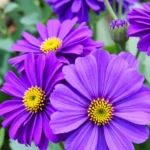Grape hyacinths care tips and benefits for your garden

Grape hyacinths are a delightful addition to any garden, bringing vibrant colors and charming beauty as spring arrives. With their striking blue flowers and hardy nature, these small bulbs offer not only aesthetic value but also a variety of uses and benefits for gardeners. Let’s explore the fascinating world of grape hyacinths and discover what makes them so special.
- Understanding grape hyacinths
- Planting grape hyacinths: Tips for success
- Care and maintenance of grape hyacinths
- Are grape hyacinths poisonous?
- Grape hyacinths and their invasive nature
- Grape hyacinths in landscaping
- Companion plants for grape hyacinths
- Grape hyacinths: A symbol of spring
- Do grape hyacinths return every year?
- To sum up.
Understanding grape hyacinths
Grape hyacinths, scientifically known as Muscari armeniacum, are bulbous perennials that herald the arrival of spring. Native to southeastern Europe, these plants produce conical clusters of urn-shaped flowers, typically in a stunning shade of deep violet blue. Each flower stem can reach up to 8 inches tall and may carry between 20 to 40 flowers, creating a dense and eye-catching display.
These bulbs are resilient and adaptable, thriving in various conditions as long as they are not subjected to overly soggy soil. Their unique appearance resembles a cluster of grapes, hence the common name, and they can add a burst of color to both formal gardens and naturalistic landscapes alike.
Planting grape hyacinths: Tips for success
Planting grape hyacinths is a straightforward process that even novice gardeners can manage. Here are some key steps to ensure successful growth:
- Choose the right time: Plant grape hyacinths in the fall, ideally between September and November, to allow them to establish roots before winter.
- Prepare the soil: Ensure the soil is well-drained and enriched with organic material. Grape hyacinths prefer a slightly acidic to neutral pH.
- Planting depth: Position the bulbs approximately 3 inches deep in the soil, ensuring the pointed end faces up.
- Spacing: Space the bulbs about 3 to 4 inches apart to allow for proper growth and airflow.
- Watering: Water the bulbs after planting, but avoid overwatering, especially in heavy clay soils.
Care and maintenance of grape hyacinths
Once planted, grape hyacinths require minimal care, making them an excellent choice for busy gardeners. Here are some maintenance tips:
- Watering: Watering should be moderate. Allow the soil to dry out between rains, as overly wet conditions can lead to bulb rot.
- Fertilizing: A light application of balanced fertilizer can be beneficial in early spring to promote healthy growth.
- After flowering care: Once the flowers have faded, allow the foliage to die back naturally. This process helps the bulb store energy for the next growing season.
Are grape hyacinths poisonous?
One of the common concerns among gardeners is whether grape hyacinths are toxic to pets or humans. While Muscari is generally considered non-toxic, ingestion of large quantities may cause mild gastrointestinal discomfort. It’s always wise to supervise pets around any garden plants and consult a veterinarian if you suspect ingestion.
Grape hyacinths and their invasive nature
Grape hyacinths can become quite prolific in the garden, leading some to label them as invasive. They can spread quickly through self-seeding and bulb division, which may overwhelm more delicate plant species. To manage their spread:
- Regular monitoring: Check regularly for new sprouts and remove them if necessary.
- Controlled planting: Consider planting them in areas where their growth can be contained.
- Companion planting: Pairing grape hyacinths with other robust plants can help manage their spread while creating a beautiful display.
Grape hyacinths in landscaping
These charming bulbs are excellent for various landscaping applications, including:
- Border plantings: Their low height makes them ideal for the front of borders or edging pathways.
- Containers: Grape hyacinths can thrive in pots, allowing for versatile arrangements on patios and balconies.
- Naturalized areas: They work well in wildflower gardens or woodland settings, where they can create a natural look.
Companion plants for grape hyacinths
When planning your garden, consider pairing grape hyacinths with other spring bloomers to extend the color palette and flowering season. Some excellent companions include:
- Camassia: Their tall spikes contrast beautifully with the shorter grape hyacinths.
- Alliums: These vibrant globes add height and interest as the season progresses.
- Forget-me-nots: Their delicate blue flowers harmonize well with grape hyacinths.
Grape hyacinths: A symbol of spring
The grape hyacinth carries a rich symbolism, often associated with rebirth and renewal, fitting for their emergence in spring. In various cultures, these flowers represent joy and the beauty of life, making them a perfect gift for celebrations or to brighten someone’s day.
For a visual guide on how to plant and care for grape hyacinths, you can check out this useful video:
Do grape hyacinths return every year?
Yes, grape hyacinths are perennial plants, meaning they return year after year. With proper care, they can thrive for many seasons, often multiplying and creating beautiful clusters that enhance your garden. Their resilience makes them a favorite among gardeners looking for reliable and low-maintenance blooms.
To sum up.
Incorporating grape hyacinths into your garden can bring a refreshing burst of color and charm. Their simple care requirements, versatility in design, and symbolic meanings make them a wonderful choice for both novice and experienced gardeners alike. Whether you plant them in clusters or alongside other spring flowers, these delightful bulbs are sure to brighten your landscape.
 Rug Cleaning Tips for Oriental and Area Rugs
Rug Cleaning Tips for Oriental and Area Rugs Growing New Grass for Your Lawn in Fall Tips
Growing New Grass for Your Lawn in Fall Tips Heirloom Vegetable Varieties for Your Garden
Heirloom Vegetable Varieties for Your Garden Ochre Solenne de la Fouchardière: A Unique Perspective
Ochre Solenne de la Fouchardière: A Unique Perspective Mistakes to Avoid When Growing Cut Flowers
Mistakes to Avoid When Growing Cut FlowersIf you want to know more about similar articles like Grape hyacinths care tips and benefits for your garden you can visit category Plant Care.
Deja una respuesta